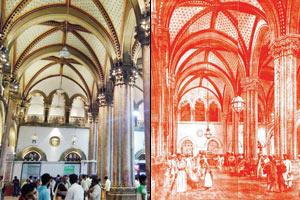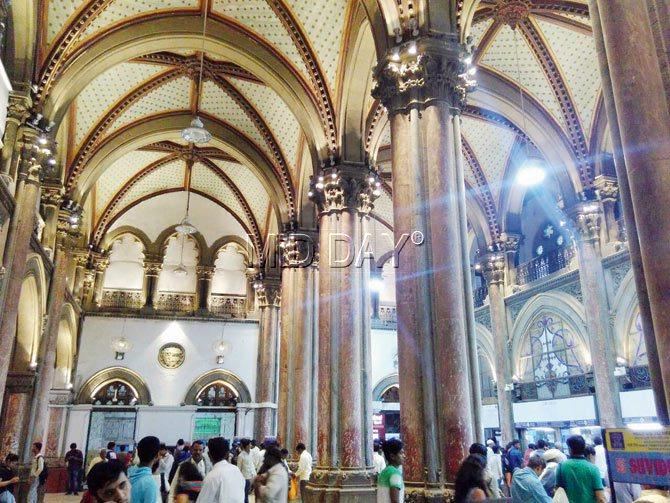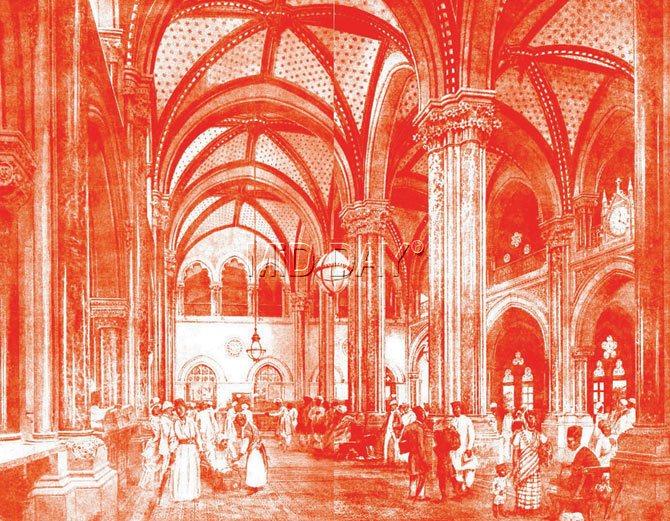CR invites citizens to join in the celebrations as the iconic terminus turns 130 on Sunday


The waiting hall, now popularly known as the Star Chamber, has barely aged since this rare illustration from October 23, 1886 (below), published in architecture journal, The Builder
Few can age as gracefully as the Chhatrapati Shivaji Maharaj Terminus (CSMT), which turns 130 years old on May 20. To mark the occasion, CR officials have planned a host of social media events.
ADVERTISEMENT
Formerly known as Victoria Terminus or VT, the building's construction began in 1878 and was completed in 1888. At the time, the terminus served as the headquarters of India's first railway company, the Great Indian Peninsula Railway (GIPR), which is the predecessor to the modern-day Central Railway (CR).

Highlight rail
Sunil Udasi, chief public relations officer for CR, said, "The crowning point of the whole building is the central dome, carrying the statue of a lady pointing a flaming torch upwards in her right hand and a spoked wheel low in her left hand, symbolising progress. This dome has been reported to be the first octagonal ribbed masonry dome that was adapted to an Italian Gothic-style building."
Another well known architectural feature of the UNESCO-listed World Heritage Site is the waiting hall, now popularly known as the Star Chamber. It gets this moniker from the groined roof, which is painted in a shade of azure with gold stars. The hall has barely changed from its heyday; it has a wealth of the choicest Italian marble, polished Indian blue stone and elaborate stone arches covered with carved foliage and images of mythical figures. Other features here include a mosaic-decorated floor, glazed dado tiles, stained glass windows, galleries of highly ornamented iron work executed by students of JJ School of Arts, and long counters made of cleverly blended wood, ebony, teak and sewan.
Difficulties
"The planning and construction of the terminus had a long and chequered history. Having failed to obtain suitable designs from England, the GIP directors selected Frederick William Stevens from the Public Works Department as their architect, and commissioned him as a salaried officer to design the new terminus at Bori Bunder," said Kunal Tripathi, who runs the popular social media account Mumbai Heritage.
He added that planning of the building is simple, with large working spaces. Stevens conceived a simple arrangement of large rooms with high ceiling, surrounded by verandahs.
CR archives state that by December 1885, the interiors were almost ready for occupation. By 1887, only the dome, the central staircase and the fixing of the sculptures remained to be completed. However, the waiting and refreshment rooms could not be opened to the public as they were yet to be connected to the city's sewerage system.
Catch up on all the latest Mumbai news, crime news, current affairs, and also a complete guide on Mumbai from food to things to do and events across the city here. Also download the new mid-day Android and iOS apps to get latest updates
 Subscribe today by clicking the link and stay updated with the latest news!" Click here!
Subscribe today by clicking the link and stay updated with the latest news!" Click here!







